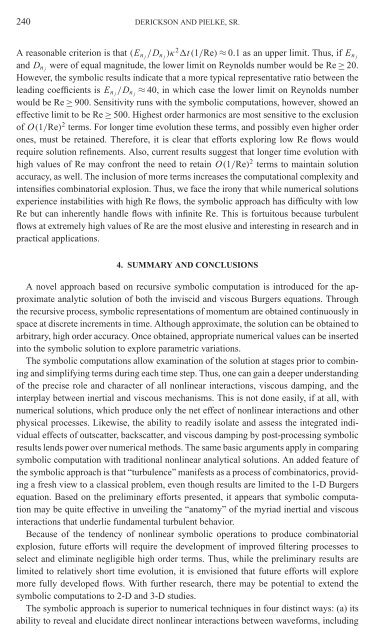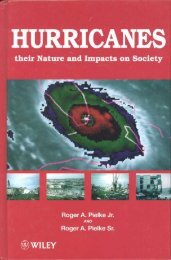A Preliminary Study of the Burgers Equation with Symbolic ...
A Preliminary Study of the Burgers Equation with Symbolic ...
A Preliminary Study of the Burgers Equation with Symbolic ...
Create successful ePaper yourself
Turn your PDF publications into a flip-book with our unique Google optimized e-Paper software.
240 DERICKSON AND PIELKE, SR.<br />
A reasonable criterion is that (En j /Dn j )κ2t(1/Re) ≈ 0.1 as an upper limit. Thus, if En j<br />
and Dn were <strong>of</strong> equal magnitude, <strong>the</strong> lower limit on Reynolds number would be Re ≥ 20.<br />
j<br />
However, <strong>the</strong> symbolic results indicate that a more typical representative ratio between <strong>the</strong><br />
leading coefficients is En j /Dn ≈ 40, in which case <strong>the</strong> lower limit on Reynolds number<br />
j<br />
would be Re ≥ 900. Sensitivity runs <strong>with</strong> <strong>the</strong> symbolic computations, however, showed an<br />
effective limit to be Re ≥ 500. Highest order harmonics are most sensitive to <strong>the</strong> exclusion<br />
<strong>of</strong> O(1/Re) 2 terms. For longer time evolution <strong>the</strong>se terms, and possibly even higher order<br />
ones, must be retained. Therefore, it is clear that efforts exploring low Re flows would<br />
require solution refinements. Also, current results suggest that longer time evolution <strong>with</strong><br />
high values <strong>of</strong> Re may confront <strong>the</strong> need to retain O(1/Re) 2 terms to maintain solution<br />
accuracy, as well. The inclusion <strong>of</strong> more terms increases <strong>the</strong> computational complexity and<br />
intensifies combinatorial explosion. Thus, we face <strong>the</strong> irony that while numerical solutions<br />
experience instabilities <strong>with</strong> high Re flows, <strong>the</strong> symbolic approach has difficulty <strong>with</strong> low<br />
Re but can inherently handle flows <strong>with</strong> infinite Re. This is fortuitous because turbulent<br />
flows at extremely high values <strong>of</strong> Re are <strong>the</strong> most elusive and interesting in research and in<br />
practical applications.<br />
4. SUMMARY AND CONCLUSIONS<br />
A novel approach based on recursive symbolic computation is introduced for <strong>the</strong> approximate<br />
analytic solution <strong>of</strong> both <strong>the</strong> inviscid and viscous <strong>Burgers</strong> equations. Through<br />
<strong>the</strong> recursive process, symbolic representations <strong>of</strong> momentum are obtained continuously in<br />
space at discrete increments in time. Although approximate, <strong>the</strong> solution can be obtained to<br />
arbitrary, high order accuracy. Once obtained, appropriate numerical values can be inserted<br />
into <strong>the</strong> symbolic solution to explore parametric variations.<br />
The symbolic computations allow examination <strong>of</strong> <strong>the</strong> solution at stages prior to combining<br />
and simplifying terms during each time step. Thus, one can gain a deeper understanding<br />
<strong>of</strong> <strong>the</strong> precise role and character <strong>of</strong> all nonlinear interactions, viscous damping, and <strong>the</strong><br />
interplay between inertial and viscous mechanisms. This is not done easily, if at all, <strong>with</strong><br />
numerical solutions, which produce only <strong>the</strong> net effect <strong>of</strong> nonlinear interactions and o<strong>the</strong>r<br />
physical processes. Likewise, <strong>the</strong> ability to readily isolate and assess <strong>the</strong> integrated individual<br />
effects <strong>of</strong> outscatter, backscatter, and viscous damping by post-processing symbolic<br />
results lends power over numerical methods. The same basic arguments apply in comparing<br />
symbolic computation <strong>with</strong> traditional nonlinear analytical solutions. An added feature <strong>of</strong><br />
<strong>the</strong> symbolic approach is that “turbulence” manifests as a process <strong>of</strong> combinatorics, providing<br />
a fresh view to a classical problem, even though results are limited to <strong>the</strong> 1-D <strong>Burgers</strong><br />
equation. Based on <strong>the</strong> preliminary efforts presented, it appears that symbolic computation<br />
may be quite effective in unveiling <strong>the</strong> “anatomy” <strong>of</strong> <strong>the</strong> myriad inertial and viscous<br />
interactions that underlie fundamental turbulent behavior.<br />
Because <strong>of</strong> <strong>the</strong> tendency <strong>of</strong> nonlinear symbolic operations to produce combinatorial<br />
explosion, future efforts will require <strong>the</strong> development <strong>of</strong> improved filtering processes to<br />
select and eliminate negligible high order terms. Thus, while <strong>the</strong> preliminary results are<br />
limited to relatively short time evolution, it is envisioned that future efforts will explore<br />
more fully developed flows. With fur<strong>the</strong>r research, <strong>the</strong>re may be potential to extend <strong>the</strong><br />
symbolic computations to 2-D and 3-D studies.<br />
The symbolic approach is superior to numerical techniques in four distinct ways: (a) its<br />
ability to reveal and elucidate direct nonlinear interactions between waveforms, including














